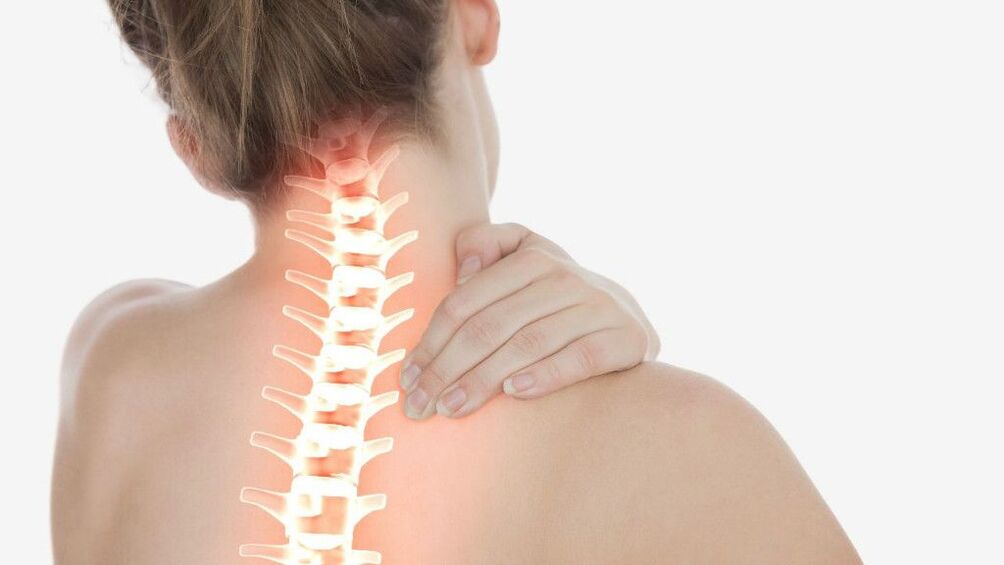Cervical spine osteochondrosis is a degenerative and dystrophic disease that affects the intervertebral discs of the neck.This pathology is the most common spinal pathology.

Symptoms of the disease
As the disease progresses, characteristic symptoms appear.They include the following manifestations:
- weakness
- Dizziness
- Headache
- Noise
- Changing the function of the viewing organ (lowering its severity, flies flying in front of eyes)
- Increased sensitivity in hand
- Numbness
- Then a person can generally stop moving his hand
- Feeling stiffness in the joints of the upper limb
- Cramping in the neck
- A feeling of stiffness and pressure on the chest.
Causes of the disease
The main causes of osteochondrosis of the cervical spine are as follows:
- Small neck mobility, which leads to the fact that the intervertebral disc loses fluid, it also leads to a loss of cartilage elasticity
- The inheritance loaded, which determines the reserve of the intervertebral disc strength
- Microtraumatization of the cervical spine with sharp curves, head slope, etc.
- Disordishes metabolic disorders that adversely affect the cartilage condition on the intervertebral disc.
Troubleshooting
Diagnostic research for cervical back osteochondrosis includes the following studies:
- RACE
- Calculated tomography
- Nuclear resonance
- Electromography.
Each of the above studies carries a certain diagnostic information.The first three allow you to identify changes directly to your back, characteristic of osteochondrosis.Recent study allows you to diagnose the complications of osteochondrosis, which consist of damage to nerve drawers.
An X -Ray examination is performed on different planes, and the images are also performed for a more accurate detail of characteristic changes.This study detects calcinates in the ligamentous apparatus of the spine, a change in the height of the intervertebral discs, deformation of the cervical region, etc.
Calculated tomography and nuclear magnetic resonance allow you to get the most reliable information, so it is recommended to use them in complex diagnostic cases.
Electromography studies conductivity in nerve fibers, which is often reduced with osteochondrosis of the cervical spine with osteochondrosis.This is due to the fact that with a decrease in the height of the intervertebral discs, conditions are created for the compression of the nerve roots.Therefore, such clinical symptoms such as increased sensitivity, paresis and paralysis appear.
Complications
Lack of timely treatment of cervical spine osteochondrosis can lead to the development of the following complications:
- The paralysis and paresis of the upper limbs in one or two sides
- Ischemic stroke of the brain.
Treatment of the disease
The goals that the pursuit of osteochondrosis follows are as follows:
- Reducing the severity of pain syndrome
- Preventing the progress of pathological changes.
The following methods are used to implement the following goals:
- Manual therapy is performed
- Acupuncture
- Physical education
- Gymnastics
- Swimming.
The goal is shown in parallel:
- Chondroprotectors, who increase the cartilage resistance and allow it to heal
- Josteroidal anti -inflammatory drugs that reduce the severity of the pain.
Unique treatment methods
- Kinesiology applied
It is a method of diagnosing and treating spinal cord diseases, joints and nervous system based on muscle testing.The doctor with the help of hands studies the condition of tissues and organs.
- Caterpillar
Along with a caterpillar bite, about 100 active ingredients biologically arrive in human blood.This helps to purify blood vessels, eliminates blood clots and interferes with their formation.
- Reflexology
Acupuncture helps cure osteochondrosis, radiculitis and other diseases of the spine and joints.Procedures relieve pain, heal the body and strengthen immunity.
Risk group
In the risk group, the following categories of people should include:
- By inheritance
- motional
- Having pathological processes in the background.
PREVENTION
Preventive measures to prevent osteochondrosis of the spine, are as follows:
- Correct stay while landing
- Alternating cargo and resting
- Excluding Weighing Weights (in this case, it is best to prioritize a backpack)
- Regular basic medical examinations for a neurologist and orthopedic for early detection of cervical spine osteochondrosis.
Diet and lifestyle
In case of osteochondrosis, it is necessary to make certain lifestyle adjustments.They are as follows:
- Treatment of the pathological process of the background, which led to osteochondrosis if it has been detected
- Exception
- Normalization of nutrition - rejection of fat, fried, acute, salty, increases the contents of plant fibers and products with chondroitin (jelly, jelly) in the diet
- A sufficient pace of physical activity.



















